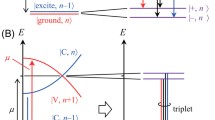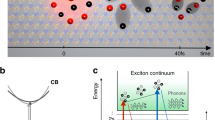Abstract
Excitonic Mott transition is a many-body crossover phenomenon where, even at zero temperature, a gas of excitons is expected to spontaneously ionize as its density or pressure is increased. Although this ionization due to the disappearance of the bound states from the energy spectra has long been predicted and continues to be studied, compelling demonstrations have been missing and the exact mechanism remains controversial. We revisit the phenomenon for silicon and report a number of striking features. The low temperature photoluminescence spectrum, around a certain crossover density shows a decrease in the emission intensity with increase in the excitation power. The photoluminescence efficiency (emission per incident photon) decreases by more than an order of magnitude building up to the Mott crossover, after which it becomes almost constant. This drastic loss in the oscillator strength is accompanied onset of a strong broadening of the excitonic peak. A comparison of this low temperature excitation power-dependent behavior of the photoluminescence emission with its temperature dependent change rules out the observations being explained by just the laser-induced heating of the sample.
Graphical abstract







Similar content being viewed by others
Data Availibility Statement
This manuscript has no associated data or the data will not be deposited. [Authors’ comment: The data that support the findings of this study are available on reasonable request from the corresponding author].
Notes
For a silicon sample mounted in the vacuum in a cold finger-based cryostat, temperatures below 20 K are sometimes unattainable due to differential heating of the sample with respect to the cold finger [38]. Unless the sample is immersed in liquid helium, the possibility of observing the electron-hole drops is eliminated [27, 29]. Many recent measurements on the Mott crossover have been deliberately performed at higher temperatures to avoid the electron-hole drop formation [23].
References
L. Canham, Introductory lecture: origins and applications of efficient visible photoluminescence from silicon-based nanostructures. Faraday Discuss. 222, 10 (2020). https://doi.org/10.1039/d0fd00018c
T. Niewelt, B. Steinhauser, A. Richter, B. Veith-Wolf, A. Fell, B. Hammann, N.E. Grant, L. Black, J. Tan, A. Youssef, J.D. Murphy, J. Schmidt, M.C. Schubert, S.W. Glunz, Reassessment of the intrinsic bulk recombination in crystalline silicon. Solar Energy Mater. Solar Cells 235, 111467 (2022). https://doi.org/10.1016/j.solmat.2021.111467
J.R. Haynes, M. Lax, W.F. Flood, Analysis of intrinsic recombination radiation from silicon and germanium. J. Phys. Chem. Solids 8, 392 (1959)
M. Khoury, M. Abbarchi, A bright future for silicon in quantum technologies. J. Appl. Phys. 131, 200901 (2022). https://doi.org/10.1063/5.0093822
H.T. Nguyen, S.C. Baker-Finch, D. Macdonald, Temperature dependence of the radiative recombination coefficient in crystalline silicon from spectral photoluminescence. Appl. Phys. Lett. 104, 112105 (2014). https://doi.org/10.1063/1.4869295
E. Wigner, H.B. Huntington, On the possibility of a metallic modification of hydrogen. J. Chem. Phys. 3, 764 (1935). https://doi.org/10.1063/1.1749590
D.S. Kothari, The theory of pressure-ionization and its applications. Proc. R. Soc. Lond. Ser. A 165, 486 (1938). https://doi.org/10.1098/rspa.1938.0073
W. Ebeling, V.E. Fortov, V. Filinov, Quantum Statistics of Dense Gases and Nonideal Plasmas (Springer, Cham, 2017). https://doi.org/10.1007/978-3-319-66637-2
N.F. Mott, Metal-insulator transition. Rev. Mod. Phys. 40, 677 (1968). https://doi.org/10.1103/RevModPhys.40.677
H.Y. Geng, Public debate on metallic hydrogen to boost high pressure research. Matter Radiat. Extrem. 2, 275 (2017). https://doi.org/10.1016/j.mre.2017.10.001
M. Kira, S.W. Koch, Many-body correlations and excitonic effects in semiconductor spectroscopy. Prog. Quant. Electron. 30, 155 (2006). https://doi.org/10.1016/j.pquantelec.2006.12.002
K.W. Böer, U.W. Pohl, Semiconductor Physics (Springer, Cham, 2018). https://doi.org/10.1007/978-3-319-69150-3
I. Pelant, J. Valenta, Luminescence Spectroscopy of Semiconductors, Luminescence Spectroscopy of Semiconductors (Oxford University Press, Oxford, 2012). https://doi.org/10.1093/acprof:oso/9780199588336.001.0001
H. Kalt, C.F. Klingshirn, Semiconductor Optics 1: Linear Optical Properties of Semiconductors (Springer, Cham, 2019). https://doi.org/10.1007/978-3-030-24152-0
G. Manzke, D. Semkat, H. Stolz, Mott transition of excitons in GaAs-GaAlAs quantum wells. New J. Phys. 14, 095002 (2012). https://doi.org/10.1088/1367-2630/14/9/095002
G.B. Norris, K.K. Bajaj, Exciton-plasma Mott transition in Si. Phys. Rev. B 26, 6706 (1982). https://doi.org/10.1103/PhysRevB.26.6706
K. Asano, T. Yoshioka, Exciton-Mott physics in two-dimensional electron-hole systems: phase diagram and single-particle spectra. J. Phys. Soc. Jpn. 83, 084702 (2014). https://doi.org/10.7566/JPSJ.83.084702
C.W. Lai, J. Zoch, A.C. Gossard, D.S. Chemla, Phase diagram of degenerate exciton systems. Science 303, 503 (2004). https://doi.org/10.1126/science.1092691
D. Semkat, F. Richter, D. Kremp, G. Manzke, W.-D. Kraeft, K. Henneberger, Ionization equilibrium in an excited semiconductor: Mott transition versus Bose-Einstein condensation. Phys. Rev. B 80, 155201 (2009). https://doi.org/10.1103/PhysRevB.80.155201
E. Baldini, T. Palmieri, A. Dominguez, A. Rubio, M. Chergui, Giant exciton Mott density in anatase TiO\(_2\). Phys. Rev. Lett. 125, 116403 (2020). https://doi.org/10.1103/PhysRevLett.125.116403
C. Jeffries, L. Keldysh, Electron-Hole Droplets in Semiconductors (North-Holland Publishing Company, Amsterdam, 1983)
A. Amo, M.D. Martìn, L. Viña, A.I. Toropov, K.S. Zhuravlev, Photoluminescence dynamics in GaAs along an optically induced Mott transition. J. Appl. Phys. 101, 081717 (2007). https://doi.org/10.1063/1.2722786
T. Suzuki, R. Shimano, Exciton Mott transition in Si revealed by terahertz spectroscopy. Phys. Rev. Lett. 109, 04642 (2012). https://doi.org/10.1103/PhysRevLett.109.046402
F. Sekiguchi, R. Shimano, Excitonic correlation in the Mott crossover regime in Ge. Phys. Rev. B 91, 155202 (2015). https://doi.org/10.1103/PhysRevB.91.155202
A. Schleife, C. Rödl, F. Fuchs, K. Hannewald, F. Bechstedt, Optical absorption in degenerately doped semiconductors: Mott transition or Mahan excitons? Phys. Rev. Lett. 107, 236405 (2011). https://doi.org/10.1103/PhysRevLett.107.236405
Y. Hayamizu, M. Yoshita, Y. Takahashi, H. Akiyama, C.Z. Ning, L.N. Pfeiffer, K.W. West, Biexciton Gain and the Mott Transition in GaAs Quantum Wires. Phys. Rev. Lett. 99, 167403 (2007). https://doi.org/10.1103/PhysRevLett.99.167403
J. Shah, M. Combescot, A.H. Dayem, Investigation of exciton-plasma Mott transition in Si. Phys. Rev. Lett. 38, 1497 (1977). https://doi.org/10.1103/PhysRevLett.38.1497
P. Grivickas, V. Grivickas, J. Linnros, Excitonic absorption above the Mott transition in Si. Phys. Rev. Lett. 91, 246401 (2003). https://doi.org/10.1103/PhysRevLett.91.246401
A.F. Dite, V.G. Lysenko, V.B. Timofeev, The kinetics of recombination radiation and the temperature of the electron-hole plasma in silicon. Phys. Stat. Sol. (b) 66, 53 (1974). https://doi.org/10.1002/pssb.2220660104
L. Kappei, J. Szczytko, F. Morier-Genoud, B. Deveaud, Direct observation of the Mott transition in an optically excited semiconductor quantum well. Phys. Rev. Lett. 94, 147403 (2005). https://doi.org/10.1103/PhysRevLett.94.147403
M. Shahmohammadi, G. Jacopin, G. Rossbach, J. Levrat, E. Feltin, J.-F. Carlin, J.-D. Ganiére, R. Butté, N. Grandjean, B. Deveaud, Biexcitonic molecules survive excitons at the Mott transition Nat. Comm. 5, Article number: 5251 (2014). https://www.nature.com/articles/ncomms6251
F. Chiaruttini, T. Guillet, C. Brimont, D. Scalbert, S. Cronenberger, B. Jouault, P. Lefebvre, B. Damilano, M. Vladimirova, Complexity of the dipolar exciton Mott transition in GaN/(AlGa)N nanostructures. Phys. Rev. B 103, 045308 (2021). https://doi.org/10.1103/PhysRevB.103.045308
F. Sekiguchi, T. Mochizuki, C. Kim, H. Akiyama, L.N. Pfeiffer, K.W. West, R. Shimano, Anomalous metal phase emergent on the verge of an exciton Mott transition. Phys. Rev. Lett. 118, 067401 (2017). https://doi.org/10.1103/PhysRevLett.118.067401
Y. Murotani, C. Kim, H. Akiyama, L.N. Pfeiffer, K.W. West, R. Shimano, Light-driven electron-hole Bardeen-Cooper-Schrieffer-like state in bulk GaAs. Phys. Rev. Lett. 123, 197401 (2019). https://doi.org/10.1103/PhysRevLett.123.197401
G. Rossbach, J. Levrat, G. Jacopin, M. Shahmohammadi, J.-F. Carlin, J.-D. Ganiére, R. Butté, B. Deveaud, N. Grandjean, High-temperature Mott transition in wide-band-gap semiconductor quantum wells. Phys. Rev. B 90, 201308(R) (2014). https://doi.org/10.1103/PhysRevB.90.201308
D. Guerci, M. Capone, M. Fabrizio, Exciton Mott transition revisited. Phys. Rev. Mater. 3, 054605 (2019). https://doi.org/10.1103/PhysRevMaterials.3.054605
R. Zimmermann, Many-Particle Theory of Highly Excited Semiconductors (Teubner, Leipzig, 1988)
P.J. Dean, J.R. Haynes, W.F. Flood, New radiative recombination processes involving neutral donors and acceptors in silicon and germanium. Phys. Rev. 161, 711 (1967). https://doi.org/10.1103/PhysRev.161.711
W.S. Yoo, K. Kang, G. Murai, M. Yoshimotob, Temperature dependence of photoluminescence spectra from crystalline silicon. ECS J. Solid State Sci. Technol. 4, 456 (2015). https://doi.org/10.1149/2.0251512jss
G.G. MacFarlane, T.P. Mclean, J.E. Quarrington, V. Roberts, Fine structure in the absorption-edge spectrum of Si. Phys. Rev. 111, 1245 (1958). https://doi.org/10.1103/PhysRev.108.1377
F.A. Johnson, Lattice absorption bands in silicon. Proc. Phys. Soc. 73, 265 (1958). https://doi.org/10.1088/0370-1328/73/2/315
M. Lax, in Proceedings of the International Conference on Semiconductor Physics, Exeter 14, 395 (1962)
W.P. Dumke, Two-phonon indirect transitions and lattice scattering in Si. Phys. Rev. 118, 938 (1960). https://doi.org/10.1103/PhysRev.118.938
R.B. Hammond, D.L. Smith, T.C. McGill, Temperature dependence of silicon luminescence due to splitting of the indirect ground state. Phys. Rev. 35, 1535 (1975). https://doi.org/10.1103/PhysRevLett.35.1535
R.J. Elliot, Intensity of optical absorption by excitons. Phys. Rev. 108, 1384 (1957). https://doi.org/10.1103/PhysRev.108.1384
A. Forchel, B. Laurlch, J. Wagner, W. Schmid, T.L. Reinecke, Systematics of electron-hole liquid condensation from studies of silicon with varying uniaxial stress. Phys. Rev. B. 25, 2730 (1982). https://doi.org/10.1103/PhysRevB.25.2730
D.W. Snoke, J.D. Crawford, Hysteresis in the Mott transition between plasma and insulating gas. Phys. Rev. E 52, 5796 (1995). https://doi.org/10.1103/PhysRevE.52.5796
F. Sekiguchi, R. Shimano, Rate equation analysis of the dynamics of first-order exciton Mott transition. J. Phys. Soc. Jpn. 86, 103702 (2017). https://doi.org/10.7566/JPSJ.86.103702
R.K. Pathria, P.D. Beale, Statistical Mechanics, 3rd edn. (Elsevier, New York, 2011)
M.A. Green, Improved value for the silicon free exciton binding energy. AIP Adv. 3, 112104 (2013). https://doi.org/10.1063/1.4828730
Acknowledgements
Bhavtosh Bansal thanks the Science and Engineering Research Board, Department of Science and Technology, Government of India, for the Core Research Grant (No. CRG/2018/003282 and CRG/2022/008662). Basabendra Roy thanks Council of Scientific and Industrial Research (CSIR), India for financial support.
Author information
Authors and Affiliations
Contributions
BB conceived of the study and guided the research work. The experiments were done by BR. Both authors discussed the results and wrote the manuscript.
Corresponding author
Ethics declarations
Conflict of interest
The authors have no conflicts to disclose.
Supplementary Information
Below is the link to the electronic supplementary material.
Supplementary Material
The Supplementary Material discusses the temperature dependence of the photoluminescence spectra. (146 KB)
Rights and permissions
Springer Nature or its licensor (e.g. a society or other partner) holds exclusive rights to this article under a publishing agreement with the author(s) or other rightsholder(s); author self-archiving of the accepted manuscript version of this article is solely governed by the terms of such publishing agreement and applicable law.
About this article
Cite this article
Roy, B., Bansal, B. Exciton-to-plasma Mott crossover in silicon. Eur. Phys. J. D 78, 24 (2024). https://doi.org/10.1140/epjd/s10053-024-00814-w
Received:
Accepted:
Published:
DOI: https://doi.org/10.1140/epjd/s10053-024-00814-w




